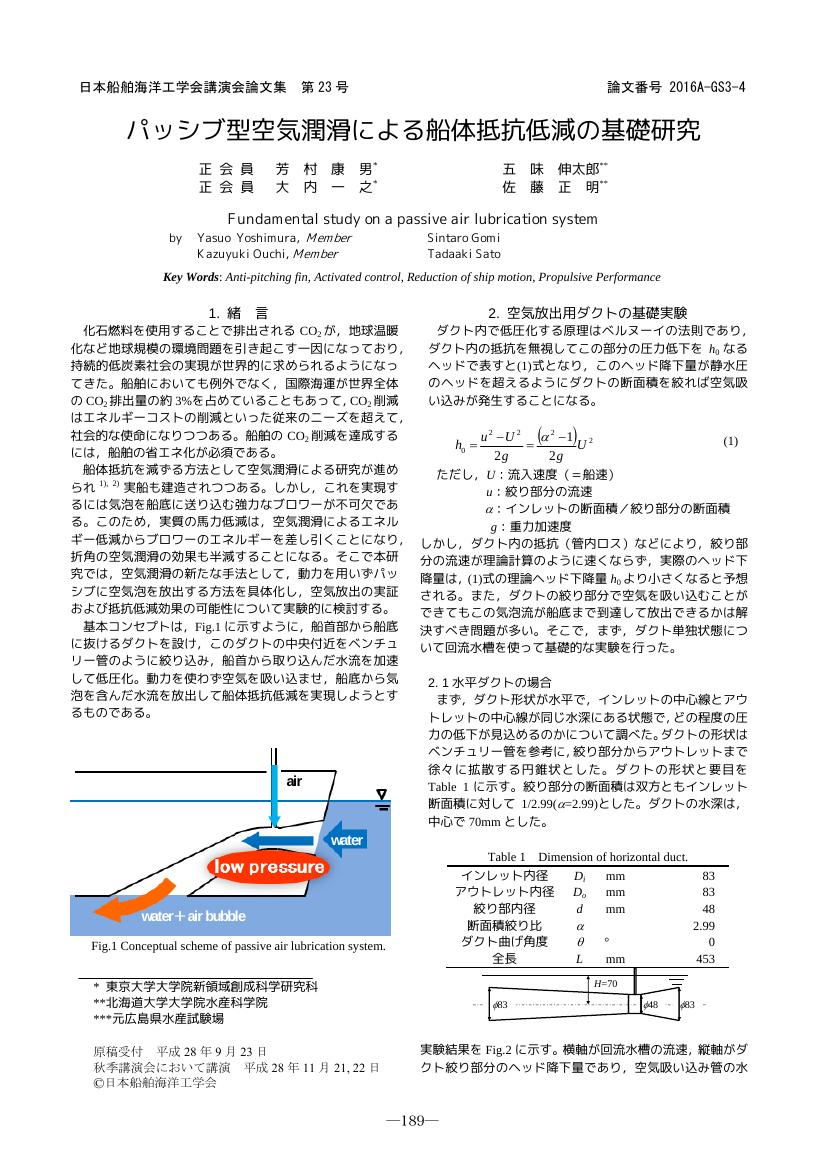1 0 0 0 OA 2016A-GS3-4 パッシブ型空気潤滑による船体抵抗低減の基礎研究
- 著者
- 芳村 康男 五味 伸太郎 大内 一之 佐藤 正明
- 出版者
- 公益社団法人 日本船舶海洋工学会
- 雑誌
- 日本船舶海洋工学会講演会論文集 23 (ISSN:24241628)
- 巻号頁・発行日
- pp.189-192, 2016-11-21 (Released:2022-11-10)
1 0 0 0 OA 新しい航路設計基準(<特集>港湾航路の設計)
- 著者
- 大津 皓平 平野 雅祥 芳村 康男 津金 正典 高橋 宏直
- 出版者
- 公益社団法人 日本船舶海洋工学会
- 雑誌
- 日本船舶海洋工学会誌 KANRIN(咸臨) (ISSN:18803725)
- 巻号頁・発行日
- vol.20, pp.6-18, 2008-09-10 (Released:2018-03-30)
1 0 0 0 OA バルジによる漁船の船型改良について
- 著者
- 川島 敏彦 芳村 康男 鈴木 四郎 大本 耕司
- 出版者
- The Japan Society of Naval Architects and Ocean Engineers
- 雑誌
- 日本造船学会論文集 (ISSN:05148499)
- 巻号頁・発行日
- vol.2003, no.193, pp.1-9, 2003 (Released:2007-05-30)
- 参考文献数
- 7
- 被引用文献数
- 3
Fishing boats have several restrictions on their machinery arrangements and space utility on deck. For the improvement of the stability and the deck utility, the fitting of a bulge on sidewall of the vessel is one of the solutions. However, the bulge generally makes a significant increase of hull resistance and loss of speed.At the principal design stage of the elongation of the fisheries research ship“Ushio-maru”, the University of Hokkaido, the authors examined the suitable form of the bulge to improve the stability without increase of the hull resistance. For this purpose, systematic calculations of wave making resistance by Rankine's source method and model experiments using a circulating water channel have been conducted. In this process, it has been found that the optimized bulge form can decrease the hull resistance.In this paper, the authors discuss about the mechanism of the hull resistance decrease by a bulge based on the view point of flow field around hull and propose the suitable method to design the bulge form. Thistechnique has been applied to the actual elongation design of“Ushio-maru”, and then it has been confirmed by the experimental model tests as well as the full scale trials.
1 0 0 0 操縦運動中の横揺れ応答モデル
- 著者
- 寺田 大介 安川 宏紀 芳村 康男 松田 真司
- 出版者
- 公益社団法人 日本船舶海洋工学会
- 雑誌
- 日本船舶海洋工学会論文集 (ISSN:18803717)
- 巻号頁・発行日
- vol.30, pp.49-57, 2019
<p>A roll response model during maneuvering, which can express a transient motion after steering, is proposed. The transient motion, namely the transition process from initial inward heel to outward heel, is used in the rudder–roll stabilization system. Nowadays, the model reference control is well used as an autopilot system of the actual ship. As to the model, the yaw response model such as the K–T model proposed by Nomoto is used because of the convenient adjustment of parameters. However, there is not the roll response model to be able to use for the rudder–roll stabilization. In this study, the 4th order roll response model proposed by Yasukawa and Yoshimura which was obtained from the 4 degrees of freedom (surge-swayroll- yaw) mathematical maneuvering model is focused on. And it is called as the Y–Y model in this study. Firstly, assume that the change of the rolling against steering is gradual, the Y–Y model is approximated by the 2nd order. Moreover, the modeling is done by considering the fact that the rolling due to steering is a non–minimum phase system. In order to verify the effectiveness of the proposed model, the numerical experiments were carried out. The KCS container ship was selected as the sample, since there is the information of maneuvering derivatives, which was obtained by the captive model experiments, including the effect of rolling. As the result, it can be confirmed that the proposed model can be expressed rolling in the transient situation after steering well under the assumption used in the modeling of Y–Y model. Furthermore, the procedure to estimate the parameters is also proposed by using the measured onboard monitoring data, and the effectiveness is confirmed based on the numerical experiment.</p>
1 0 0 0 OA 小型漁業調査練習船「うしお丸」の船体延長改造
- 著者
- 芳村 康男 梶原 善之 千田 忠雄
- 出版者
- 公益社団法人 日本船舶海洋工学会
- 雑誌
- Techno marine 日本造船学会誌 (ISSN:09168699)
- 巻号頁・発行日
- vol.874, pp.498-504, 2003-07-10 (Released:2018-03-28)
- 参考文献数
- 5
1 0 0 0 OA 日本の漁船スパンカーの空力特性
- 著者
- 芳村 康男 雨宮 伊作 鋤柄 みのり 今泉 哲
- 出版者
- 日本水産工学会
- 雑誌
- 日本水産工学会 学術講演会 学術講演論文集 2008年度 日本水産工学会 学術講演会 講演論文集 (ISSN:09173943)
- 巻号頁・発行日
- pp.207-210, 2008 (Released:2020-03-02)
- 参考文献数
- 2
1 0 0 0 統合型減揺フィンの基礎研究
船体の左右に一対のフィンを船首あるいは船尾付近に装備し、このフィンの角度を効果的に制御することによって、横揺れだけでなく、縦揺れ、および船首揺れをも減少させようとする新しい統合型減揺フィンの開発をめざして研究を行い、本年度は以下の成果を達成した。1)既存の漁業調査船を供試模型船(全長:約2m)とし、フィンの取付け位置を前年度の理論検討結果を用いて、より効果的な場所に変更し、水槽実験を実施した結果、縦揺れ・横揺れの双方に有効な結果が得られた。2)上記の模型実験は、20年度と同様、船を曳航する方式で減揺性能を確認したが、最終年度にあたる21年度は、模型船に舵・プロペラを装備して模型船を波浪の中を自走させ、向波だけでなく、横波斜波中の実験を実施した。使用した水槽は(株)IHI横浜研究所の大型角水槽である。また、模型船は無線操縦によって操船を行った。この実験の結果本減用システムは、種々の波向きの航走でも有効なことが確認できた。3)上記の実験を行う中で、減用フィンが操縦性能に及ぼす影響についても調査した。その結果、船首フィンの場合は、波浪中を直進するに際して、舵角を大きくとり、やや操船しにくいが、逆に船尾フィンの場合は、保針に要する舵角も小さく、操船し易いことが明らかとなった。4)以上の実験結果から、統合型の減用フィンは船尾に装備することが望ましいことが判明した。5)上記の研究成果は総合的に評価を行い、その結果を21年度の北海道大学の修士論文1件、および卒業論文1件としてまとめた。



